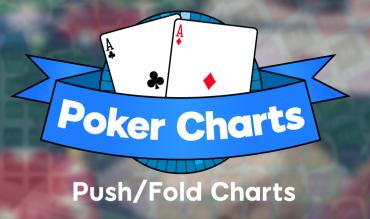Through the development over the recent years of poker technology used for off-table study (i.e. various poker solvers and applications), knowledge and implementation of optimal, unexploitable poker strategies and plays.
For the purpose of this article, specifically, those involving appropriate push/fold and call ranges for various stack sizes, have surged to the forefront.
One such tool that has helped better the playing of tournament players is something called the “Nash Push/Fold Equilibrium”.
The chart below shows which hands you can be open-shoving with (e.g. when you’re getting short-stacked in a tournament) depending on your stack size, whereby you can remain indifferent to if your opponent calls or folds.
Ultimately, in the long-term, shoving as per the chart’s recommendations will lead to +EV situations, whether it’s through the fold equity you have if your opponent folds, or the equity that you’ll have against an appropriate calling range for the situation.
Table of Contents
- Understanding Push/Fold Equilibrium Charts
- How To Improve your Push/Fold Game for Other Positions
- Off-Table Study: Push/Fold Ranges
- Understanding ICMIZER Push/Fold Charts
- ICMIZER Push/Folds Charts: 12bb + Ante
- Using Other Notations for Push/Fold Charts
- Adjusting for Opponents’ Tendencies
- The Next Step: Experimenting With Hand Equities
- Other Uses and Applications for Push/Fold Charts
Understanding Push/Fold Equilibrium Charts
It must be noted that the charts below are intended explicitly for heads-up play. Therefore, for games with more than 2 players, the shove (all-in) tables below are applicable for SB open-shoving ranges, and the call chart below are relevant only for BB situations vs a SB shove.
Here’s the Nash Push/Fold Equilibrium chart, as referenced above:
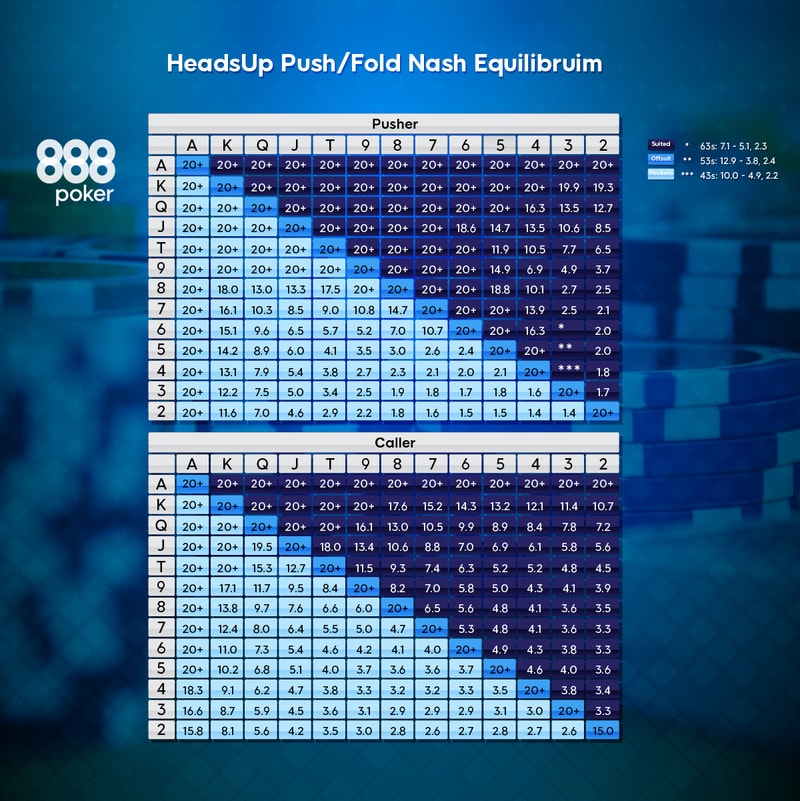
It should be noted that the push chart below can also be used when you’re short-stacked and are looking to push from the Button. When doing this, to account for the extra player that you’ll be shoving into (the player in the Small Blind), simply divide all the numbers in the chart by 2.
If you have 95s on the Button and the action is folded to you, you can profitably shove, if you have a stack of 7.2bb or less.
By the same thought, if you divide all of the original numbers in the chart by 4, you’ll find a solid pushing range from the CO. Some of the figures will be impossible to calculate accurately for the CO, though, and/or positions further to the right of the blinds because the highest value that the chart provides is “20+” big blinds, which is used for many hands in the table.
How To Improve your Push/Fold Game for Other Positions
To assist you with optimal push/shoving ranges for the rest of the positions (EP/MP/CO) and stack sizes at the table, poker pro, Max Silver developed an incredible phone application called SnapShove just for that purpose! (The app is available on the App Store for iOS and Google Play for Android.)
A free version is available with a more “basic” version of the app, but for a nominal one-time price, you can unlock the full version, which provides complete flexibility and customizability for any position you may find yourself in at the table:
- Number of Players
- Ante/Big Blind
- Number of Big Blinds you have (or the effective stack is)
- Your Position
Simply input the above information accordingly, tap “Calculate”, and watch the application spit out the correct shoving range for that given situation.
Here’s a screenshot of the layout within the app:

Furthermore, if you’re looking for something to tell you how wide (or narrow) a range you should be calling with when facing a shove, this app has you covered, too.
See the “call” tab along the top? With all of the same customisability (yet merely adding in a box for inputting the position of your opponent who’s shoving), you can then press calculate and see the appropriate ranges you should be calling within that situation.
Off-Table Study: Push/Fold Ranges
Apps like SnapShove can help provide you with a quick push/fold refresher, in-game and at the tables.
Studying push-fold ranges in-depth away from the table will undoubtedly help put you on the road to becoming a tournament master.
Many pros use a standard website/program to help them with their push/fold game called ICMIZER - www.icmpoker.com/icmizer.
| NOTE: Need a quick refresher on what ICM is and why it’s so applicable and necessary for succeeding in tournaments? Check out our in-depth article on the topic here! |
We’ll dive into some more specific push/fold charts shortly. But first, it’s essential to look at some factors that go into dictating ideal shoving ranges and strategies.
Factors and Considerations Affecting Push/Fold Ranges
Here’s a list of just a few factors that influence push/fold ranges. You’ll also find out how they might also affect your overall shortstack strategy:
- Your Stack Depth: The fewer big blinds you have, the wider you can shove. Your stack size will also dictate whether you should utilise more of a push/fold strategy (i.e., with 10bb or less). Or if you should come in for a min-raise instead, looking to play some post-flop poker (i.e., with 20bb or more).
- Opponents’ Stack Depths: You always want to consider the effective stack size of your opponents. See who might have a shorter stack than you. This insight will influence your opponents’ expected calling ranges, impacting your shoving hands. Remember that if you have 15bb but all your opponents have 10bb. Then you’re only shoving for 10bb – not 15bb!
- Ante Size: With more chips in the pot preflop (with antes), you should be looking to have a wider shoving range than if there were none. The bigger the ante size (relative to the big blind), the more hands you can include in your preflop shoving range.
- Table Position: The further you are away from the big blind, the tighter your open-shoving range must be. You’ll have to “get through more players”. The more players, the higher the likelihood that at least one of them will wake up with a hand good enough to play.
- Tournament Structure: The faster-paced the tournament levels are, the more need to “chip up” and accumulate a larger stack. As such, in tournaments with short levels, you need to push more frequently in spots with marginally +EV. Oppositely, with slower tournament structures, you don’t need to push in as many of those marginal spots.
- Payout Structure: This situation is where ICM comes into play! Before a significant pay bump and especially when you’re at the final table, you should consider (1) your opponent’s sizing and (2) the payout structure. Say someone has 20bb, you have 10bb, and there are three mega shortstacks with just 5bb. You’re going to want to take far fewer chances with your 10bb stack. Let the 5bb stacks double up or bust first, allowing you to climb up the payout ladder.
- Opponent Skill Level: The more skilled your opponents are, the more you should be looking to play a push-or-fold game. This strategy involves playing less post-flop. You should be focusing on shoving any hand that is profitable to shove at your current effective stack depth (especially for any stack size ).
- Your Skill Level: The more post-flop skill you have, the more you should use this. Stick to stack depth sizes that you can profitably either shove or open-raise (such as stacks between 12bb and 20bb).
Understanding ICMIZER Push/Fold Charts
In the ICIMIZER charts, you’ll see small numbers below each hand in the charts. These numbers show just how profitable (or unprofitable) a shove will be.
They depict the average number of big blinds you will win or lose with these holdings.
To help understand these numbers even better, multiply them by 100, and you’ll get a bb/100 winrate.
For example, a hand has 0.35 underneath it. That number means shoving will net you about 35bb/100 hands, on average.
This rate is quite a healthy margin to shove confidently!
ICMIZER: What Do The Various Colours Mean?
- Put simply, you should shove the hands in green and fold the hands in red.
- The darker the green box is, the more profitable the hand is to shove.
- The solid green square represents your “slam-dunk” shoves, which will net on average +0.20bb per hand (20bb/100).
- The thinner shoves will appear in a much fainter green (between +0.01 and +0.19bb per hand).
- All unprofitable hands will appear in red. These are the hands that carry a negative win rate in the long term if they get shoved preflop. So, it would be best if you folded them.
ICMIZER Push/Folds Charts: 12bb + Ante
We’re going to use ICMIZER to help show ideal push/fold ranges for the following situation:
- 12bb stack size
- 12.5% ante collected each hand from each player
- 9-handed table
Early Position: UTG / UTG+1
7.39% with 0.20 min EV Diff
12.67% with all +EV hands
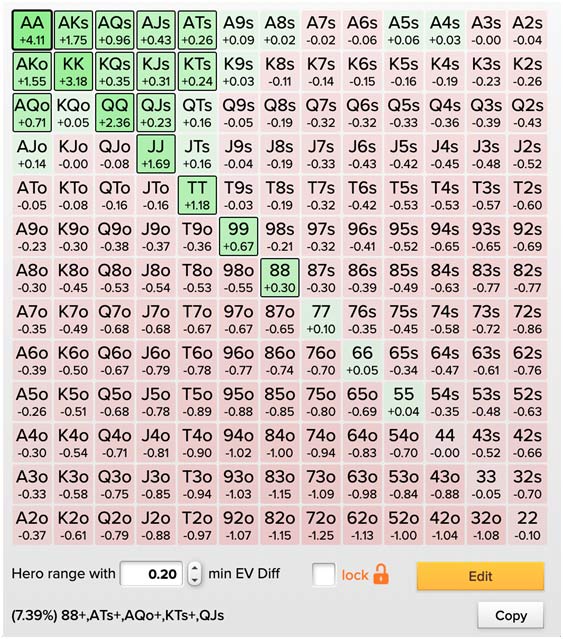
Early Position: UTG+2
9.8% with 0.20 min EV Diff
17.5% with all +EV hands
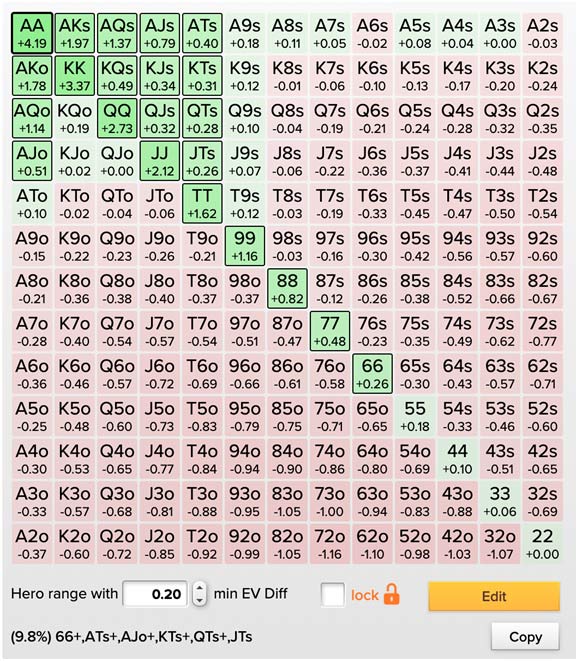
Middle Position: Lojack
13.12% with 0.20 min EV Diff
21.21% with all +EV hands
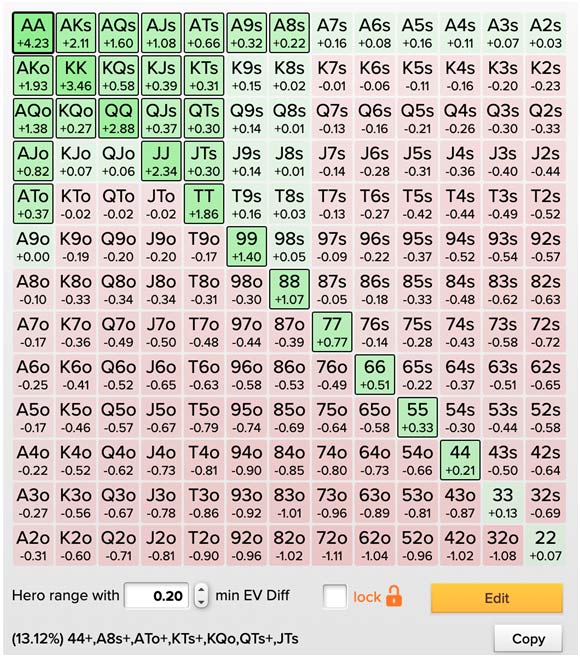
Middle Position: Hijack
15.99% with 0.20 min EV Diff
26.49% with all +EV hands
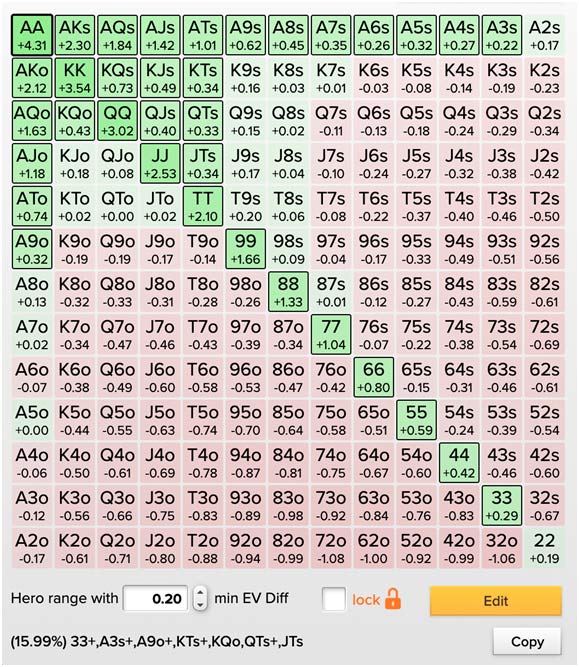
Late Position: Cutoff
23.68% with 0.20 min EV Diff
33% with all +EV hands
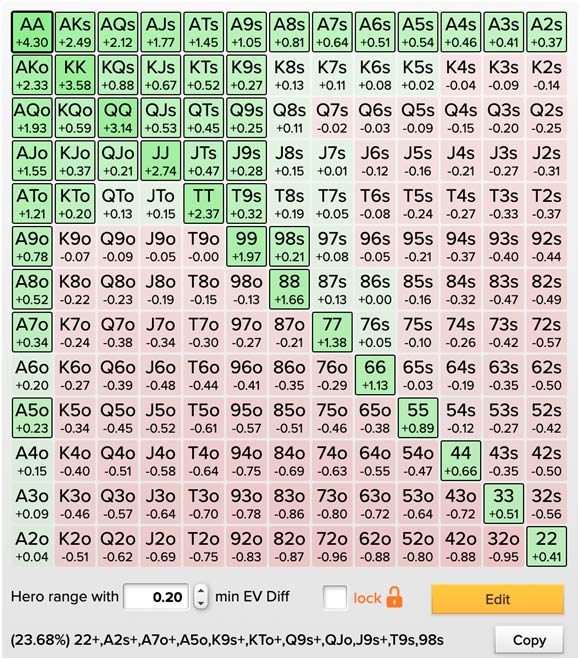
Late Position: Button
30.92% with 0.20 min EV Diff
39.22% with all +EV hands
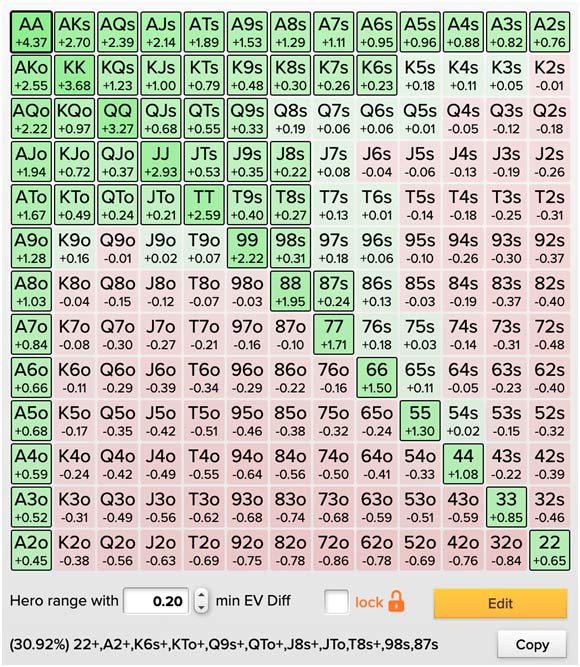
Late Position: Small Blind
55.35% with 0.20 min EV Diff
69.65% with all +EV hands
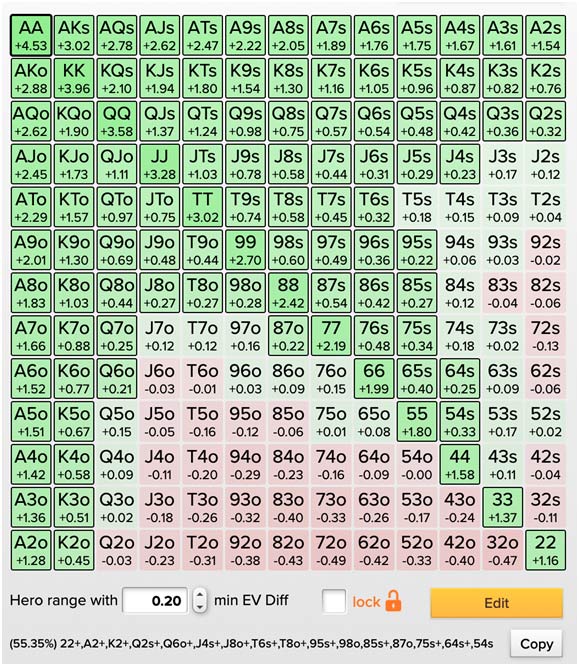
Using Other Notations for Push/Fold Charts
Shoving Ranges: Percentages
Some charts list what to do push/fold situations (e.g., when using study materials other than ICMIZER). Sometimes it will show what percentage of hands to shove.
If this is the case, you can use any poker equity program to help give a visual representation of hands.
Utilise software like PokerCruncher for Mac or Equilab for Windows to drag the bar and show the chart.
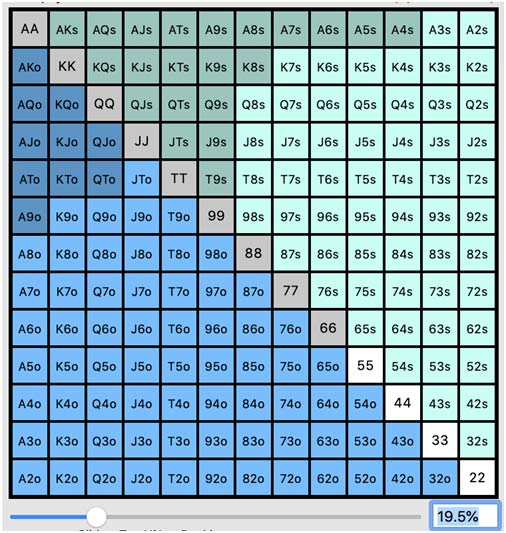
For example, using PokerCruncher, you should be shoving about 20% of hands in a specific spot.
You can drag the bar just below the chart in the program to around 20% to see a visual representation (shown in the darkened squares).
- Think that some hands should be excluded from the specific range?
- Perhaps the top 20% is somewhat arbitrary when ranking exactly which hands are better than others?
Then deselect some hands and use others when constructing my exact ranges (i.e., if using 55 instead of A4s).
Shoving Ranges: Hand Notation
Some programs or sites may list shoving ranges in hand notation -
- 66+, A9s+, A5s, AQo+, KTs+, QTs+, JTs
Want a visual representation of how these might look?
You can also copy/paste these notations into the above software programs:
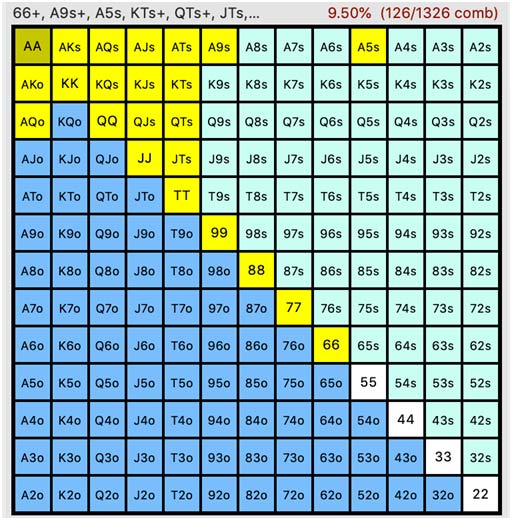
Adjusting for Opponents’ Tendencies
You can modify to a small degree which hand ranges you may choose to shove in specific spots,
You can base this strategy expressly on whether your opponent is calling with an optimal range or not:
If your opponent is calling too tightly:
- Then this scenario increases your chipEV all-around for all your hands! You will now win the blinds and antes with greater frequency when you push and your opponent folds.
- This strategy can transform some slightly losing pushes into winning all-in plays. (Of course, this result depends on how much more they are folding than optimal.)
- It will also increase the EV of some marginal winning all-ins. You'll turn them into more “slam-dunk” all-ins, instead of borderline, like before.
If your opponent is calling too loosely:
- Your chipEV will increase marginally for most hands you’d already be shoving (especially the good ones). But your variance will also skyrocket.
- Many players combat this by only pushing with a much narrower range than their stack size suggests. This adjustment is incorrect. They’ll be losing out on +EV situations with the medium-strength hands they are now choosing to fold.
- Against these looser-calling players, you usually need to strap in for the ride. Stick to your standard shoving ranges (perhaps countering by opening them up just slightly)
Embrace the variance!
The Next Step: Experimenting With Hand Equities
You can also use poker equity calculators to see why particular hands might perform better in shove situations than others.
For example, let’s take A5s vs a higher suited connector, like T9s. We’ll pit this against a calling range of 22+, ATs+, KJs+, AJo+ (shown below in the chart):
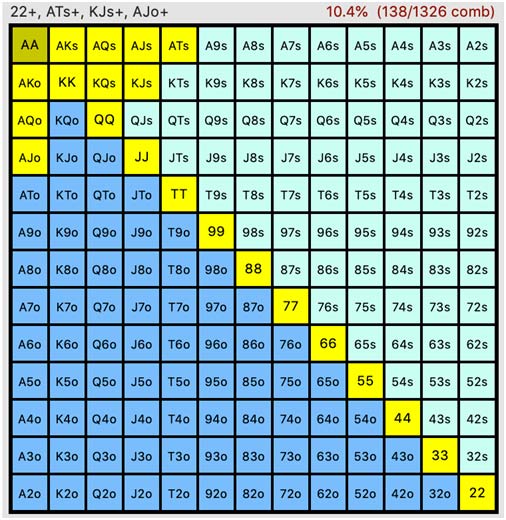
A2s would typically beat T9s when put against each other (with a 55.5% equity advantage).
But, against the range shown above, A2s suffers more than a hand like T9s by nearly six percentage points!


So, toy with equity calculators and see how specific hands do against particular calling ranges.
This process can help you determine which hands to push with and how to build your ranges.
Other Uses and Applications for Push/Fold Charts
It’s not only in MTT’s where you can use these tools to improve your game. Think about how a SNG grinder can up their game using these charts. With most of their money always coming from the top 3 spots, the skills of a solid push/fold game become mighty prevalent and can add huge profits to their bottom line.
In Conclusion
Ultimately, using the Nash Push/Fold chart provided above, in conjunction with Apps like SnapShove, is going to improve your short-stack game significantly in tournaments, helping you make more deep runs and consistent profits.
That said, always stay modest in your results and keep in mind the variance that is naturally a part of tournaments (with the number of all-in shove/call-off moments there are where you either have to hold or improve).
Using these apps will help arm you with the knowledge you need to make long-term +EV shortstack decisions, but variance is still going to play its course over the short-term.
With that in mind, as you improve and get better, remember that volume will help you overcome whatever variance you’ll experience.
The more tournaments you play, the more your skill edge in all the push/fold situations you’ll encounter will be shown.
Good luck on the felts!
